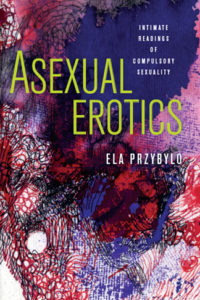Book Review: Asexual Erotics
The perception of Asexuality as an orientation has largely become more prominent since the late 1990s with the launching of AVEN (the Asexuality Visibility and Education Network in 2001) and the rapid increase of awareness and activism that it spawned in questioning assumptions regarding compulsory sexuality. While landmark researchers such as Kinsey had previously identified (with an “X”) those people for whom sexual desire was either very low or absent, bloggers and activists were at the vanguard of identifying Asexuality as a discreet orientation that was typified as “a person who does not experience sexual attraction.”
While not wanting to challenge or dismiss those people for who the self-identification as Asexual or “Ace” has been central to their process of self-understanding and definition, Ela Przybylo, in her book Asexual Erotics: Intimate Readings of Compulsory Sexuality (Ohio State University Press, 2019) invites us to be curious about the way in which we apply the boundaries around sexual orientations and identities. Her work is a decidedly Queer project in which she challenges us to loosen the fixed absolute and instead tune into the subtler nuances of what she describes as “asexual resonances”.
 In digging into the phenomena of asexual lives, Przybylo highlights the paradox of having a sexual orientation defined by the absence of sexual activity and also the acknowledgement that (as with other orientations), people may use a label because it captures a vital dimension of their experience without necessarily conveying the complex terrain of peoples’ actual lives. While asexual advocates might be drawn to the legitimacy offered by the concrete categorisation of sexological science, a Queered reading might follow Eve Kosofsky Sedgwick in advocating “the open mesh of possibilities, gaps, overlaps, dissonances and resonances.”
In digging into the phenomena of asexual lives, Przybylo highlights the paradox of having a sexual orientation defined by the absence of sexual activity and also the acknowledgement that (as with other orientations), people may use a label because it captures a vital dimension of their experience without necessarily conveying the complex terrain of peoples’ actual lives. While asexual advocates might be drawn to the legitimacy offered by the concrete categorisation of sexological science, a Queered reading might follow Eve Kosofsky Sedgwick in advocating “the open mesh of possibilities, gaps, overlaps, dissonances and resonances.”
Central to this work is Ela’s creative use of Audre Lorde’s conception of an expanded eroticism and the challenge this provides to the messages many of us have received. In our post-Freudian era, many have viewed the erotic as being synonymous with sexual activity (especially heterosexual intercourse), both Lorde and Przybylo ask us to explore a much broader pallet of sensuality that moves beyond genitally focused reductionism. What follows in her work is an exploration of how asexual resonances and tendencies can be read into some vital chapters of recent history from the mid-twentieth century onwards.
I really enjoyed her exploration of how various groups and movements during the late 1960s and early 1970s sought to explore elective celibacy as a means of personal and collective liberation. Groups such as Cell 16 and the Young Lords along with Valerie Solanas’ SCUM manifesto are read through the lens of erotic asexuality and are seen as valuing a similar impulse with regards the reclamation of both space and selfhood. Przbylo sees such asexual tendencies as being key to a liberation in which both white women and women of colour were able to free themselves from expectations regarding the need for partnered relationships, compulsory reproduction or home building.
In an age where sex positivity is thankfully becoming increasingly the norm, Ela is highly aware that a superficial reading of asexuality may view it as a dysfunction, a repression or as a result of trauma. In a culture of medicalised categorisation, it might be easy to view asexual resonances as being pathological in nature. Przybylo works with this idea of “failure” and challenges us to adopt a Queer reading in which the refusal to engage in compulsory sexual activity can be seen as both freeing and a position of conscious radicalism.
In her creative reading of the concepts of both “Lesbian Bed Death” and Spinsterhood, she explores the way in which such “Queer failure” seeks to reject those forms of Liberal capitalism that seek to see old age as synonymous with disposability and that compulsory coupledom and sustained sexual activity are the only path to erotic fulfilment. For Przybylo the ambiguity and subtlety of asexual erotics provide an alternate path in which the quality of the connection is valued above external markers of success.
Such asexual erotics contrast markedly with forms of suppression or denial that don’t have their origins in consent and in the closing chapter of the book Ela spends time considering the recent killings that occurred in Toronto that were committed by an Involuntary Celibate or “Incel”. The Incel operates from the misogynist assumption that they as cisgendered, predominantly white men are entitled to sex from women and are willing to resort to violence in obtaining it. Unlike conscious asexuality that has its origins in a self-recognition regarding a lower degree of sexual attraction, the Incel movement comes from a profoundly unerotic place.
In short, I really enjoyed this book and felt that it was breaking helpful new ground in its reading of recent history and the way in which asexual resonances are present within Feminist, Queer and Black forms of liberation. The concepts that Przybylo explores are complex but her writing is lucid and engaging. Highly recommended.
